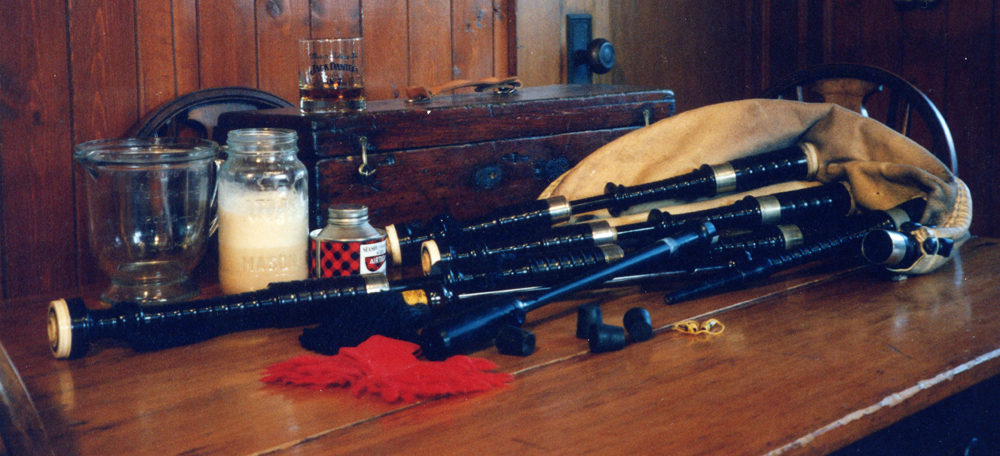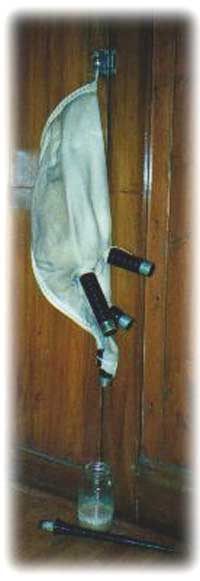Periodically, it is wise to test the bag to determine if indeed it is airtight. In every "Care & Maintenance Workshop" I've ever conducted I have never been disappointed. We've always discovered at least one bag that is leaking air.
Remove the chanter and three drones. Place corks into the open end of the drone and chanter stocks. The best corks are made of rubber and readily form an airtight seal when inserted into the stock. These corks are available through any bagpipe supplies dealer or at your local wine-making supplies store. Blow into the bag through the blowpipe until the bag is fully inflated. Place the bag under your arm and press it against your side. You can also put the inflated bag on the floor and kneel upon it with one knee. The bag should remain fully inflated, as theoretically the air has nowhere to escape. Wait about twenty seconds or so. Try to blow into the blowpipe again. If the bag is airtight, you should not be able to blow additional air into the bag.
Remove the chanter and three drones. Place corks into the open end of the drone and chanter stocks. The best corks are made of rubber and readily form an airtight seal when inserted into the stock. These corks are available through any bagpipe supplies dealer or at your local wine-making supplies store. Blow into the bag through the blowpipe until the bag is fully inflated. Place the bag under your arm and press it against your side. You can also put the inflated bag on the floor and kneel upon it with one knee. The bag should remain fully inflated, as theoretically the air has nowhere to escape. Wait about twenty seconds or so. Try to blow into the blowpipe again. If the bag is airtight, you should not be able to blow additional air into the bag.
The foundation of the bagpipe is the bag itself. The bag acts as a reservoir for air, receiving amounts blown into it and transferring a steady supply to the reeds. The bag also “manages” moisture that is blown into it, contained within your breath. A properly functioning bag should be airtight and allow or help the piper to maintain the proper moisture level within the reeds at all times.
Five stocks are tied or fastened directly to the bag. Air enters the bag through the blowpipe stock and exits the bag through reeds contained within the drones and chanter.
Five stocks are tied or fastened directly to the bag. Air enters the bag through the blowpipe stock and exits the bag through reeds contained within the drones and chanter.
If the bag does not remain fully inflated, then the search is on to find the leak or leaks.
Use a systematic approach:
1. Check the corks to ensure the seal is tight
2. Make sure that there are no cracks in any stocks. Check around the top of each stock for small hairline cracks. These may open when corks or drones are inserted.
3. Make sure that the blowpipe valve is functioning properly. It should close quickly and seal tightly, allowing little or no air to escape back up the blowpipe.
4. Check around the base of each stock. They should be tightly fastened to the bag and no air should be escaping where they are each fastened to the bag.
5. Check the bag itself. Each type of bag seems to have its own particular vulnerability. Hide bags may leak down the seam. Sheepskin bags may develop a thin spot, where seasoning and air escape. Gortex bags can develop leaks almost anywhere, as the enzymes from our breath will break down those properties within the material which make it airtight. A particularly vulnerable spot is that area just beneath the blowpipe stock. These bags may also leak around the zipper or clamp.
In any respect, the leak must be located and assessed. The bag must then either be repaired or replaced.
Use a systematic approach:
1. Check the corks to ensure the seal is tight
2. Make sure that there are no cracks in any stocks. Check around the top of each stock for small hairline cracks. These may open when corks or drones are inserted.
3. Make sure that the blowpipe valve is functioning properly. It should close quickly and seal tightly, allowing little or no air to escape back up the blowpipe.
4. Check around the base of each stock. They should be tightly fastened to the bag and no air should be escaping where they are each fastened to the bag.
5. Check the bag itself. Each type of bag seems to have its own particular vulnerability. Hide bags may leak down the seam. Sheepskin bags may develop a thin spot, where seasoning and air escape. Gortex bags can develop leaks almost anywhere, as the enzymes from our breath will break down those properties within the material which make it airtight. A particularly vulnerable spot is that area just beneath the blowpipe stock. These bags may also leak around the zipper or clamp.
In any respect, the leak must be located and assessed. The bag must then either be repaired or replaced.
Seasoning a Hide Bag



